Monolayer detection of ion binding at a crown ether-functionalised supramolecular surface via an integrated optical Bragg grating†
Abstract
There have been significant recent developments in the field of integrated optical Bragg grating sensors for use in the biological domain, where changes in the thickness of a surface layer upon specific binding of biological targets allows quantitative detection. However in the chemical domain less work has been reported. We present here an integrated optical Bragg grating sensor, capable of evanescently detecting small changes in refractive index down to 10−6 RIU at infrared wavelengths, within a microfluidic system. The high spectral fidelity of the Bragg gratings combined with precise thermal compensation enables direct monitoring of the surface throughout the experiment. This allows the sensor to probe surface changes in situ and in real-time, from preparation through to chemical modification of the surface, so that the progress of dynamic surface-localized interactions can be followed. Here we describe confirmatory studies to validate this approach, including a comparison with the modelled optical system, before assessing the ability to detect binding of Group I cations at a crown ether-functionalised supramolecular surface. Unlike larger biological entities, for these small chemical species, simple additive changes in film-thickness no longer prevail.


 Please wait while we load your content...
Please wait while we load your content...